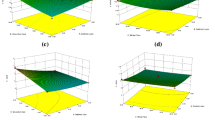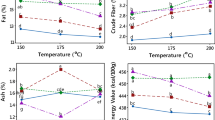Abstract
Cereal and legume flours are intensively being used by food experts to formulate cookies. But their byproducts are discarded in spite of being nutrient rich. The study was conducted to determine nutrients, organoleptic properties and shelf-life of highly nutritive multibran cookies formulated with partial replacement of wheat flour along with the milling byproducts i.e., chickpea husk, moong bean husk, rice bran, broken rice, and wheat bran. The percentages of the byproduct flour, taken for the formulation of the product, was determined using central composite design of response surface methodology. According to the obtained data, Multi-bran cookies (MBC) possessed rich nutrient composition in comparison with the control sample i.e., the wheat flour cookies (WFC). MBC showed 18% crude protein, 5% crude fiber, higher than the crude protein (7.78%) and crude fiber (2%) of WFC. However, total sugar concentrations of MBC (3.08 g/100 g) was lower than WFC (4.89 g/100 g). Calcium and phosphorus present in MBC were 115.06 mg/100 g and 195.88 mg/100 g respectively, significantly higher (p < 0.05) than WFC. The overall acceptability of MBC as indicated by 9-point hedonic scale (8.13) was satisfactory. On the basis of the obtained data it can be said that the selected milling byproducts can be used as potential plant-based sources to develop significant functional products like cookies without affecting its sensory quality and to improve nutritional status of consumer.



Similar content being viewed by others
Availability of data and materials
The data that support the findings of this study are available from the corresponding author upon reasonable request.
Code availability
Not applicable.
Abbreviations
- RSM:
-
Response surface methodology
- CCD:
-
Central composite design
- DPPH:
-
2,2-Diphenyl-1-picrylhydrazyl
- TIA:
-
Trypsin inhibitor activity
References
Aktaş K, Akın N (2020) Influence of rice bran and corn bran addition on the selected properties of tarhana, a fermented cereal based food product. LWT 129:109574
AOAC (2000) Official methods of analysis of AOAC. International 17th edition; Gaithersburg, MD, USA Association of Analytical Communities.
Avilés-Gaxiola S, Chuck-Hernández C, Serna Saldívar SO (2018) Inactivation methods of trypsin inhibitor in legumes: a review. J Food Sci 83(1):17–29
Bora P, Kulshrestha K (2015) Fiber rich snack food products incorporated with green gram husk and their suitability for diabetics. Asian J Dairy Food Res 34(4):300–306
Chibbar RN, Ambigaipalan P, Hoover R (2010) Molecular diversity in pulse seed starch and complex carbohydrates and its role in human nutrition and health. Cereal Chem 87(4):342–352
Connell JJ (1975) Control of fish quality. Fishing News (Books) Ltd., Farnham
Ghimire L (2018) Optimization of Mango peel powder with wheat flour to develop high fiber biscuit. EC Nutr 13:768–774
Dagostin JLA (2017). Use of blanching to reduce antinutrients, pesticides, and microorganisms. In New Perspectives on Food Blanching (pp. 61–94). Springer, Cham.
Dong X, Hu Y, Li Y, Zhou Z (2019) The maturity degree, phenolic compounds and antioxidant activity of Eureka lemon [Citrus limon (L.) Burm. f.]: a negative correlation between total phenolic content, antioxidant capacity and soluble solid content. Sci Hortic 243:281–289
Girotto F, Alibardi L, Cossu R (2015) Food waste generation and industrial uses: a review. Waste Manag 45:32–41
Gulati P, Brahma S, Graybosch RA, Chen Y, Rose DJ (2020) In vitro digestibility of proteins from historical and modern wheat cultivars. J Sci Food Agric 100(6):2579–2584
Hassanzadeh-Rostami Z, Abbasi A, Faghih S (2020) Effects of biscuit fortified with whey protein isolate and wheat bran on weight loss, energy intake, appetite score, and appetite regulating hormones among overweight or obese adults. J Funct Foods 70:103743
Higuchi M (2014) Antioxidant properties of wheat bran against oxidative stress. In Wheat and rice in disease prevention and health, Academic Press, pp 181–199.
Hudec J, Burdová M, Kobida LU, Komora L, Macho V, Kogan G, Chlebo P (2007) Antioxidant capacity changes and phenolic profile of Echinacea purpurea, nettle (Urtica dioica L.), and dandelion (Taraxacum officinale) after application of polyamine and phenolic biosynthesis regulators. J Agricult Food Chem 55(14):5689–5696
Kämmerer U, Klement RJ, Joos FT, Sütterlin M, Reuss-Borst M (2021) Low carb and ketogenic diets increase quality of life, physical performance, body composition, and metabolic health of women with breast cancer. Nutrients 13(3):1029
McKenzie FC, Williams J (2015) Sustainable food production: constraints, challenges and choices by 2050. Food Secur 7(2):221–233
Mertz ET, Kirleis AW and Axtell JD (1983) Invitro digestibility of proteins in major food cereals. In: Federation proceedings 9650 Rockville pike, Bethesda, MD 20814–3998: Federation Amer Soc Exp Biol 42(5): 1320–1320.
Milićević N, Sakač M, Hadnađev M, Škrobot D, Šarić B, Hadnađev TD, Pezo L (2020) Physico-chemical properties of low-fat cookies containing wheat and oat bran gels as fat replacers. J Cereal Sci 95:103056
Minatel IO, Borges CV, Ferreira MI, Gomez HAG, Chen CYO, Lima GPP (2017) Phenolic compounds: functional properties, impact of processing and bioavailability. Phenolic Compd Biol Act 1–24
Mohammadi F, Marti A, Nayebzadeh K, Hosseini SM, Tajdar-Oranj B, Jazaeri S (2021) Effect of washing, soaking and pH in combination with ultrasound on enzymatic rancidity, phytic acid, heavy metals and coliforms of rice bran. Food Chem 334:127583
Mohd Basri MS, Mohd Jais N, Sulaiman A, Mohd Nor MZ, Abdul Karim Shah NN, Ariffin SH (2020) Optimizing the processing factor and formulation of oat-based cookie dough for enhancement in stickiness and moisture content using response surface methodology and superimposition. Processes 8(7):797
Niño-Medina G, Muy-Rangel D, de la Garza AL, Rubio-Carrasco W, Pérez-Meza B, Araujo-Chapa AP, Urías-Orona V (2019) Dietary fiber from chickpea (Cicer arietinum) and soybean (Glycine max) husk byproducts as baking additives: functional and nutritional properties. Molecules 24(5):991
Okaka JC (1997) Cereals and legumes: storage and processing technology. Data and Microsystem Publishers, Enugu, Nigeria, pp 11–124
Oluwajuyitan TD, Ijarotimi OS, Fagbemi TN (2020) Nutritional, biochemical and organoleptic properties of high protein-fibre functional foods developed from plantain, defatted soybean, rice-bran and oat-bran flour. Nutr Food Sci 51(4):704–724
Peryam DR, Pilgrim FJ (1957) Hedonic scale method of measuring food preferences. Food Technol 11:9–14
Rico-Munoz E, Samson RA, Houbraken J (2019) Mould spoilage of foods and beverages: using the right methodology. Food Microbiol 81:51–62
Shi L, Arntfield SD, Nickerson M (2018) Changes in levels of phytic acid, lectins and oxalates during soaking and cooking of Canadian pulses. Food Res Int 107:660–668
Singh Sibian M, Singh Riar C (2020) Optimization and evaluation of composite flour cookies prepared from germinated triticale, kidney bean, and chickpea. J Food Process Preserv 45:e14996
Singh U, Kherdekar MS, Jambunathan R (1982) Studies on desi and kabuli chickpea (Cicer arietinum L.) cultivars. The levels of amylase inhibitors, levels of oligosaccharides and in vitro starch digestibility. J Food Sci 47(2):510–512
Singleton VL, Rossi JA (1965) Colorimetry of total phenolics with phosphomolybdic-phosphotungstic acid reagents. Am J Enol Vitic 16(3):144–158
Sohail M, Rakha A, Butt MS, Iqbal MJ, Rashid S (2017) Rice bran nutraceutics: a comprehensive review. Crit Rev Food Sci Nutr 57(17):3771–3780
Somogyi M (1945) Determination of blood sugar. J Biol Chem 160:69–73
Suhag R, Dhiman A, Deswal G, Thakur D, Sharanagat VS, Kumar K, Kumar V (2021) Microwave processing: a way to reduce the anti-nutritional factors (ANFs) in food grains. LWT 150: 111960
Suleria HA, Barrow CJ, Dunshea FR (2020) Screening and characterization of phenolic compounds and their antioxidant capacity in different fruit peels. Foods 9(9):1206
Tiwari U, Gunasekaran M, Jaganmohan R, Alagusundaram K, Tiwari BK (2011) Quality characteristic and shelf life studies of deep-fried snack prepared from rice brokens and legumes by-product. Food Bioprocess Technol 4(7):1172–1178
Xiang J, Li W, Ndolo VU, Beta T (2019) A comparative study of the phenolic compounds and in vitro antioxidant capacity of finger millets from different growing regions in Malawi. J Cereal Sci 87:143–149
Yemm EW, Willis A (1954) The estimation of carbohydrates in plant extracts by anthrone. Biochemical J 57(3):508–514
Acknowledgements
We acknowledge DST-SERB, India (Sanction order no. ECR/2017/001285) for this study.
Funding
This research did not receive any specific grant from funding agencies for publication.
Author information
Authors and Affiliations
Contributions
Manali Chakraborty- Investigation, Data analysis, Drafting, Writing, Editing. Savita Budhwar (Corresponding Author)- Supervising, Proposal drafting, Methodology, Validation of Data analysis, Proof reading, Editing. Suneel Kumar- Supervising, Validation of Data analysis, Proof reading, Editing.
Corresponding author
Ethics declarations
Conflict of interest
Authors disclose no conflict of interest.
Consent to participate
All authors gave their consent to participate in this study.
Consent for publication
All authors gave their consent for the publication of this manuscript article.
Ethics approval
This research article does not contain any studies with human participants or animals performed by any of the authors.
Additional information
Publisher's Note
Springer Nature remains neutral with regard to jurisdictional claims in published maps and institutional affiliations.
Supplementary Information
Below is the link to the electronic supplementary material.
Rights and permissions
Springer Nature or its licensor holds exclusive rights to this article under a publishing agreement with the author(s) or other rightsholder(s); author self-archiving of the accepted manuscript version of this article is solely governed by the terms of such publishing agreement and applicable law.
About this article
Cite this article
Chakraborty, M., Budhwar, S. & Kumar, S. Evaluation of nutrients and organoleptic value of novel value added multibran cookies using multivariate approach. J Food Sci Technol 59, 4748–4760 (2022). https://doi.org/10.1007/s13197-022-05559-1
Revised:
Accepted:
Published:
Issue Date:
DOI: https://doi.org/10.1007/s13197-022-05559-1




